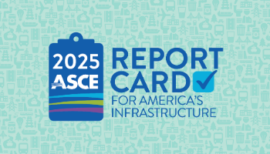Inland Waterways
Startup Uses Drone for Cleaning Water, Collecting Data
Kern County is the 3rd largest geographically in California with 8,161 square miles – larger than Connecticut and Delaware combined. Bakersfield is the largest city and the county seat with 376,000 people. This makes Bakersfield the 9th largest city in California and the 52nd largest in the nation – larger than Cincinnati, Ohio, or St. Louis, Missouri. We are the largest agricultural producing county in California at more than $7 billion annually, and the 2nd largest oil producing county in the nation (4% of total U.S. oil production).
Infrastructure is the backbone of our daily lives and communities. While we don’t always acknowledge it, the condition of our infrastructure has a very real impact on every person and business. We all depend on roads and bridges to get us where we are going, water infrastructure that delivers clean water to our taps, and a system of roads, rail, and transit to move goods and people that fuel our economy.
An expert team of local civil engineers and industry professionals from public agencies, private consultants, and contractors were assembled to evaluate nine infrastructure categories of Kern County. The results have been reviewed and scrutinized by ASCE’s team of national experts, the Committee on America’s Infrastructure.
Thanks to major investments over the past 10 years, Kern County’s transportation network has increased capacity and improved levels of service, but sustainable funding is needed to maintain these upgraded assets. The Thomas Roads Improvement Program and the Caltrans State Route widening project have increased capacity and helped maintain an acceptable level of service or better for Kern County residents. Additionally, the number of bridges requiring significant repair or upgrades decreased from 9.1% in 2008 to 2.5% in 2017, which is well below the national average. The funding provided by the state legislature through passage off the 2017 transportation package is helpful, but a local funding source must be identified to supplement state funding and sustain recent road and bridge improvements.
Transit and parks infrastructure have been shortchanged by recent budget cycles and must be prioritized going forward. In both cases, as existing revenue sources have remained constant or declined, costs have continued to rise. Ten years ago, a full‐time parks employee would have been responsible for 9.2 acres, but today that same employee is responsible for 12.6 acres. Additional staff is needed to maintain the existing level of service. Meanwhile, public transit in Kern County GET & Kern Transit have invested in fleet upgrades over the last 10 years, but significant funding will be required in the coming years to accommodate potential growths in ridership and to meet anticipated state‐wide zero emission requirements.
The Report Card was created to help Kern County residents understand the state of our infrastructure. As civil engineers, our job is to plan, design, construct, and maintain our infrastructure networks and this document allow us the opportunity to share that information with the public. The Report Card provides a snapshot for residents and policymakers to engage in conversation about where we are and where we want to be. We hope that this information provides the insight needed to start that conversation and ignite action.
Download Executive SummaryWe can no longer afford to defer investment in our nation’s critical infrastructure systems.
Smart investment will only be possible with leadership, planning, and a clear vision for our nation’s infrastructure.
We have to utilize new approaches, materials, and technologies to ensure our infrastructure is more resilient.

2025 Drinking Water & Wastewater Webinar: Key Insights from ASCE
December 18, 2025
Exploring Infrastructure Grades, Challenges, and Solutions for U.S. Drinking Water & Wastewater Systems Overview of the Webinar On December 11, ASCE hosted an insightful webinar...

West Virginia 2025 Infrastructure Report Card: ASCE Grades & Key Needs
December 17, 2025
On Wednesday, December 17, the West Virginia Section of the American Society of Civil Engineers (ASCE) released its 2025 Report Card for West Virginia’s Infrastructure...

Florida’s Infrastructure Report Card: A ‘C+’ and Climbing
December 10, 2025
The 2025 Report Card for Florida’s Infrastructure is out, and the Sunshine State earned a ‘C+’. Florida joins Georgia, Nevada, Utah, and Wisconsin as the...
Select your home state, and we'll let you know about upcoming legislation.
"*" indicates required fields